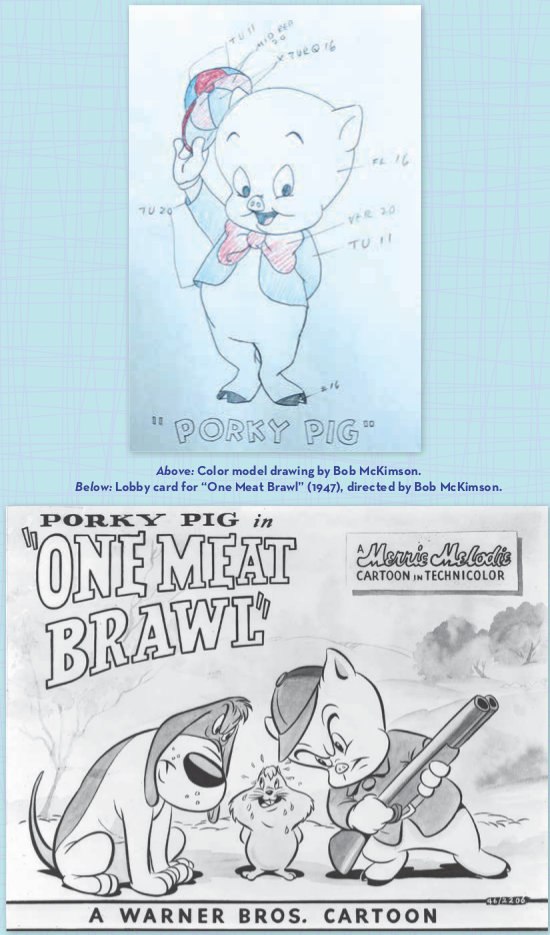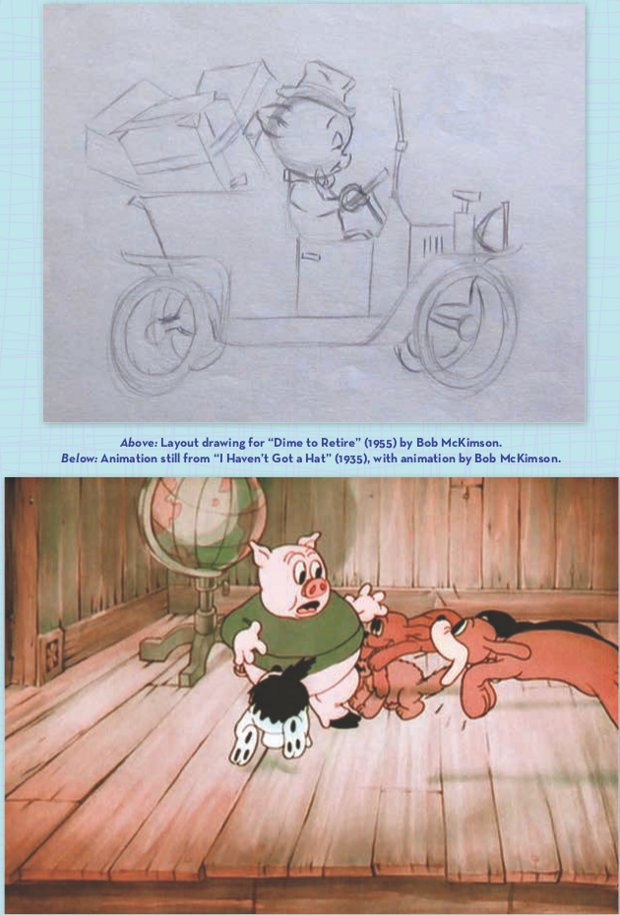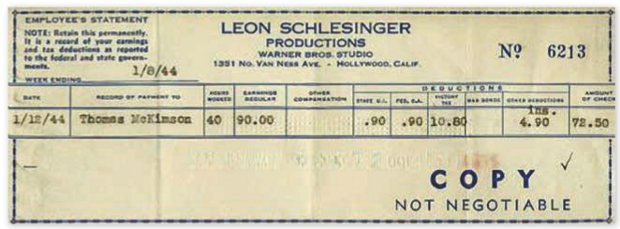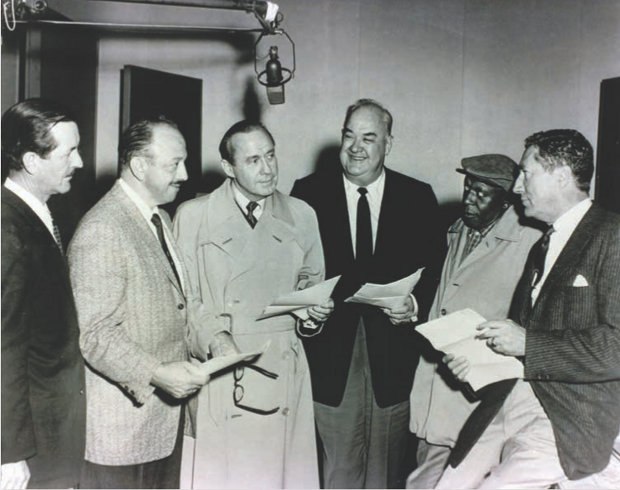Fred Patten reviews Robert McKimson Jr.’s richly detailed new book about the life and career of his prolific father and uncles.
Solana Beach, CA, Santa Monica Press, November 2012, hardcover $45.00 (232 pages), Kindle $28.22.
If asked to name the most famous and legendary Warner Bros. cartoon directors, most people would name Bob Clampett, Chuck Jones, Friz Freleng, and maybe Tex Avery or Frank Tashlin. Few would name Bob McKimson as one of Warner Bros.’ “greats,” Yet Bob McKimson had the longest career at the Leon Schlesinger/Warner Bros. studio. He also helped develop the personalities of WB’s most popular cartoon megastars such as Bugs Bunny and Porky Pig, and undisputedly created more of the famous Warner Bros. “second string” cartoon stars such as Foghorn Leghorn, Speedy Gonzales, and the Tasmanian Devil; as his son Robert McKimson Jr. shows in this thoroughly researched and profusely illustrated biography of his father and his two equally talented cartoonist brothers. And after Warner Bros. closed down its animation unit in 1963, Bob McKimson continued to work at several other Hollywood animation studios creating theatrical and TV animation cartoons from Mr. Magoo to the Pink Panther. Bob McKimson is overdue for animation history recognition, and his son has given it to him in this book.
Robert McKimson was born in 1910, the middle of three brothers who were all gifted cartoonists. He and Tom began to work at the Walt Disney studio in 1929, but quit in 1930 to join the animation staff of Romer Gray who was starting a new studio. Gray’s underfinanced studio ran out of money in 1931 after four theatrical cartoons starring Binko the Bear Cub were drawn but not produced. Bob and Tom next went to work for Harmon-Ising Productions, who were making Bosko cartoons for Leon Schlesinger Productions for release through Warner Bros. In 1933 Harmon-Ising and Schlesinger had a falling-out and split into two separate studios. Tom went with Harmon-Ising, while Bob stayed for what became over thirty years at Schlesinger’s, which was eventually bought out by Warner Bros.
“Schlesinger considered Bob McKimson to be the fastest animator in the studio, and they had an excellent rapport.” (p. 41) In 1935 Fred “Tex” Avery became one of Schlesinger’s four directors, and Bob McKimson was assigned to his unit along with new animators Bob Clampett and Chuck Jones. Before that, McKimson had worked with Schlesinger’s other directors, Friz Freleng, Jack King, and Earl Duvall. He worked on the first Porky Pig, Daffy Duck, and Bugs Bunny cartoons from the mid-1930s while Clampett, Jones and others were promoted around him. Finally in 1944, when Frank Tashlin quit just after Leon Schlesinger sold his studio to Warner Bros. and retired, Bob McKimson became a director.
McKimson Jr. recounts his father’s career as a director, often working with his brothers who had joined the Warner Bros. staff by this time. He describes WB’s later cartoon characters such as Pepe le Pew and the Coyote and the Road Runner, but he goes into the greatest detail over the characters that his father created, especially Foghorn Leghorn, the tall Southern-accented rooster who was tiny Henery Hawk’s foil. McKimson also worked on many Bugs Bunny and Sylvester P. Pussycat cartoons and others (McKimson created Sylvester’s son, Sylvester Jr.), which are described. Tom McKimson left Warner Bros. in 1947 for the Los Angeles office of Western Publishing, the company that produced the licensed comic books and coloring books of most animation studios’ funny-animal characters, including Warner Bros.
In 1953 Jack Warner briefly closed the animation department to concentrate on 3D movies. He quickly changed his mind and reopened the animation studio, but while it was closed, Chuck left to work with Tom at Western Publishing. Bob stayed with Warner Bros. until it closed its animation department for good in 1963. His last work for WB animation was for the combination live-action/animated The Incredible Mr. Limpet, featuring Don Knotts who is turned into a fish.
After that Robert McKimson worked briefly at UPA on Mr. Magoo cartoons, at Warner Bros.-Seven Arts on such forgettable new cartoons as Cool Cat and Rapid Rabbit, and at DePatie-Freleng Enterprises on the Pink Panther. He was working at DePatie-Freleng when he died in 1977.
This recitation of facts gives no hint of the beauty of this book. It is illustrated in full color on almost every page, and with several double-page art spreads. There are illustrations of almost everything that Robert McKimson has done, from pencil sketches of the never-produced Binko cartoons for Romer Gray to all of his work for Warner Bros. and the later studios. There are animation drawings, color model drawings, finished cels, lobby cards, model sheets, limited edition cels, and more. A separate chapter on Tom and Chuck’s work at Western Publishing has many samples of their work on WB-character comic books and coloring books, from rough scripts to finished drawings. Chuck’s only separate animation credit was on the TV cartoon series Calvin and the Colonel; he later worked at Pacific Title creating motion picture animated titles for such features as The Music Man and The Sound of Music. There are sharp photographs (mostly posed publicity photos) throughout the book, not only of the three McKimson brothers throughout their lives, but also of the men they worked with: Leon Schlesinger, Friz Freleng, Chuck Jones, Eddie Selzer, Mel Blanc, and more.
The Foreword and Introduction stand out above those in other animation scholarship books. John Kricfalusi and Darrell Van Citters are animation industry veterans who are very knowledgeable about the McKimson brothers, and include many personal insights in their combined twelve pages.
The book is not perfect. There is no index, which would have been handy. Practically every Warner Bros. cartoon that McKimson Jr. mentions is called a “classic,” which becomes overkill fast. In the decades-old debate of who created Bugs Bunny, McKimson Jr. comes down solidly on his father’s side, although he does acknowledge most of Bugs’ other “fathers,” and he reproduces Warner Bros.’ 1944 copyright registration form for the “cartoon Figure named ‘Bugs Bunny’” identifying Robert McKimson as the artist. There are several minor nitpicks; for example, the book does not mention that Friz Freleng was a nickname; his real first name was Isadore. A model sheet of Oswald, the Lucky Rabbit is dated 1928 and identified as Walter Lantz’s; it does look more like Lantz’s Oswald, but in 1928 the rabbit was still Disney’s.
But for information and samples of Robert McKimson’s animation, and Tom McKimson’s comic book and coloring book work (which Bob sometimes helped on), “I Say, I Say…Son!” A Tribute to Legendary Animators Bob, Chuck, and Tom McKimson will probably never be bettered. Every animation library should have this book.
--
Fred Patten has been a fan of animation since the first theatricalrerelease of Pinocchio (1945). He co-founded the first Americanfan club for Japanese anime in 1977, and was awarded the Comic-Con International's Inkpot Award in 1980 for introducing anime to American fandom. He began writing about anime for Animation WorldMagazine sinceits #5, August 1996. A major stroke in 2005 sidelined him for severalyears, but now he is back. He can be reached at fredpatten@earthlink.net.













